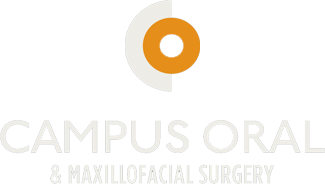Platelet Rich Plasma (PRP) is exactly what its name suggests. The substance is a by-product of blood (plasma) that is rich in platelets. Until now, its use has been confined to the hospital setting. This was due mainly to the cost of separating the platelets from the blood (thousands) and the large amount of blood needed (one unit) to produce a suitable quantity of platelets.
New technology permits the doctor to harvest and produce a sufficient quantity of platelets from only 55 cc of blood drawn from the patient while they are having outpatient surgery. At Campus Oral and Maxillofacial Surgery, we are proud to be one of the few offices offering this technological advancement.
Why all the excitement about PRP?
A subfamily of TGF, is bone morphogenic protein (BMP). BMP has been shown to induce the formation of new bone in research studies in animals and humans. This is of great significance to the surgeon who places dental implants. By adding PRP, and thus BMP, to the implant site with bone substitute particles, the implant surgeon can now grow bone more predictably and faster than ever before.
PRP has many clinical applications:
Bone grafting for dental implants. This includes onlay and inlay grafts, sinus lift procedures, ridge augmentation procedures, and closure of cleft, lip and palate defects.
Repair of bone defects creating by removal of teeth or small cysts.
Repair of fistulas between the sinus cavity and mouth.
PRP also has many advantages:
- Safety: PRP is a by-product of the patient’s own blood, therefore, disease transmission is not an issue.
- Convenience: PRP can be generated in the doctor’s office while the patient is undergoing an outpatient surgical procedure, such as placement of dental implants.
- Faster healing: The supersaturation of the wound with PRP, and thus growth factors, produces an increase of tissue synthesis and thus faster tissue regeneration.
- Cost effectiveness: Since PRP harvesting is done with only 55 cc of blood in the doctor’s office, the patient need not incur the expense of the harvesting procedure in hospital or at the blood bank.
- Ease of use: PRP is easy to handle and actually improves the ease of application of bone substitute materials and bone grafting products by making them more gel-like.
Frequently asked questions about PRP:
- Is PRP safe? Yes. During the outpatient surgical procedure a small amount of your own blood is drawn out via the IV. This blood is then placed in the PRP centrifuge machine and spun down. In less than fifteen minutes, the PRP is formed and ready to use.
- Should PRP be used in all bone-grafting cases? Not always. In some cases, there is no need for PRP. However, in the majority of cases, application of PRP to the graft will increase the final amount of bone present in addition to making the wound heal faster and more efficiently.
- Will my insurance cover the costs? Unfortunately not. The cost of the PRP application (approximately $400) is paid by the patient.
- Can PRP be used alone to stimulate bone formation? No. PRP must be mixed with either the patient’s own bone, a bone substitute material such as demineralized freeze-dried bone, or a synthetic bone product, such as BIO-OSS.
- Are there any contraindications to PRP? Very few. Obviously, patients with bleeding disorders or hematologic diseases do not qualify for this in-office procedure. Our surgeon will determine if PRP is right for you.


